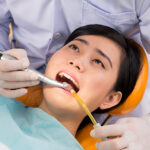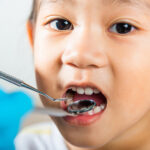Getting a dental filling is a common procedure, but the question that lingers for many is: can you eat after a filling? This seemingly simple question opens up a world of considerations for your oral health and the longevity of your dental work. Whether you’ve received a traditional amalgam filling or a modern composite filling, understanding the nuances of post-filling care is crucial. This article will delve deep into the ins and outs of eating after a filling, covering everything from immediate precautions to long-term care, ensuring your smile stays radiant and healthy.
Understanding the Basics
The primary reason for caution after a filling is to allow the material to fully set and harden. Traditionally, amalgam fillings, made of a mixture of metals, harden relatively quickly. However, modern composite fillings, which are tooth-colored and aesthetically pleasing, require a bit more time to cure completely. The curing process is often accelerated with a special blue light during the procedure, but the material continues to harden for a short period afterward.
Immediate Post-Filling Care: What to Expect
Immediately after your filling, you might experience some numbness from the local anesthetic. This numbness can last for a few hours, making it easy to accidentally bite your cheek, tongue, or lip. Therefore, it’s generally recommended to avoid eating until the numbness wears off. This precaution is particularly important for children, who may not be as aware of their surroundings.
Can You Eat After a Filling? The Timing Matters
The exact timeframe for when you can eat after a filling depends on the type of filling you received.
- Amalgam Fillings: With amalgam fillings, you can generally eat within a few hours after the numbness subsides. However, it’s best to stick to softer foods for the first 24 hours to allow the filling to fully harden.
- Composite Fillings: Composite fillings are cured with a special light, making them relatively hard immediately after the procedure. However, it’s still advisable to avoid very hard or sticky foods for a few hours.
Foods to Avoid After Composite Filling: Protecting Your Investment
While composite fillings are durable, certain foods can compromise their integrity in the initial period. Here are some key foods to avoid after a composite filling:
- Hard Foods: Avoid biting into hard candies, nuts, or ice, as these can chip or crack the filling.
- Sticky Foods: Sticky candies, caramel, and chewing gum can adhere to the filling and potentially pull it out.
- Staining Foods and Drinks: Composite fillings can be susceptible to staining, especially in the first 24-48 hours. Avoid dark-colored beverages like coffee, tea, red wine, and strongly pigmented foods like berries.
Composite Fillings Aftercare: Ensuring Longevity
Proper aftercare is essential for the longevity of your composite fillings. Here are some key tips:
- Maintain Good Oral Hygiene: Brush and floss your teeth twice daily, paying special attention to the filled tooth.
- Regular Dental Checkups: Schedule regular dental checkups and cleanings to monitor the condition of your fillings.
- Avoid Grinding or Clenching: If you grind or clench your teeth, consider wearing a nightguard to protect your fillings.
- Mind Your Bite: Be mindful of your bite and avoid chewing on hard objects like pens or fingernails.
Can You Smoke After a Filling? The Risks Involved
Smoking after a dental filling, especially in the initial period, poses several risks. Nicotine and other chemicals in cigarettes can:
- Stain Composite Fillings: Smoking can significantly stain composite fillings, compromising their aesthetic appeal.
- Delay Healing: Smoking can impede the healing process and increase the risk of infection.
- Cause Dry Socket: Especially after extractions, smoking increases the risk of dry socket, a painful condition.
- Increase Oral Health Issues: Smoking is a major risk factor for gum disease and oral cancer, which can further complicate post-filling care.
Therefore, it’s strongly recommended to avoid smoking for at least 24 hours after a filling, and ideally, quit altogether for better oral and overall health.
Madison Dentistry & Implant Center: Your Partner in Dental Health
At Madison Dentistry & Implant Center, we understand the importance of comprehensive post-filling care. Our experienced team is dedicated to providing personalized advice and guidance to ensure your fillings last and your smile remains healthy. We prioritize patient education, empowering you with the knowledge needed to make informed decisions about your dental health. We are located in Madison, and serve the surrounding area with expert care.
Actionable Tips for a Smooth Recovery
- Stick to Soft Foods: For the first few days, opt for soft foods like yogurt, mashed potatoes, and smoothies.
- Chew on the Opposite Side: Chew on the opposite side of your mouth from the filling to minimize pressure.
- Rinse with Warm Salt Water: Gently rinse your mouth with warm salt water to reduce swelling and promote healing.
- Use a Cold Compress: Apply a cold compress to your cheek to alleviate any discomfort or swelling.
- Contact Your Dentist: If you experience severe pain, swelling, or sensitivity, contact your dentist immediately.
Final Thoughts: Embracing a Healthy Smile
Understanding what to eat and avoid after a filling is crucial for ensuring the longevity of your dental work and maintaining optimal oral health. By following the guidelines outlined in this article, you can confidently navigate post-filling care and enjoy a healthy, radiant smile. Remember, communication with your dentist is key. Don’t hesitate to reach out to professionals like those at Madison Dentistry & Implant Center with any questions or concerns. We proudly serve Madison and the surrounding communities, including Chatham, Florham Park, Morristown, and Summit. Taking care of your fillings is an investment in your long-term oral health. By being mindful of your diet and maintaining good oral hygiene, you can enjoy the benefits of a healthy, beautiful smile for years to come. Schedule a consultation today!




